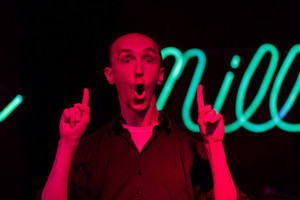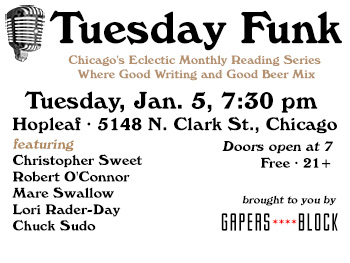| « Essay Fiesta Under New Leadership | Bookmarks » |
Events Fri Nov 16 2012
A Show for Chicago: Christopher Piatt's The Paper Machete Moves to the Green Mill
 When writer/performer Christopher Piatt first conceived of the "live magazine" phenomenon known as The Paper Machete, he envisioned it hosted at the Green Mill, where the nightly jazz, the twinkling green lights, and the ghosts of gangsters past linger in every smoky corner. And beginning Saturday, December 1--after three rigorous years hosting and producing The Paper Machete at various Lincoln Square bars--Piatt's vision is realized as he takes his weekly "salon in a saloon" to the Green Mill with headliner Katie Rich of the Second City mainstage.
When writer/performer Christopher Piatt first conceived of the "live magazine" phenomenon known as The Paper Machete, he envisioned it hosted at the Green Mill, where the nightly jazz, the twinkling green lights, and the ghosts of gangsters past linger in every smoky corner. And beginning Saturday, December 1--after three rigorous years hosting and producing The Paper Machete at various Lincoln Square bars--Piatt's vision is realized as he takes his weekly "salon in a saloon" to the Green Mill with headliner Katie Rich of the Second City mainstage.
"I'm beside myself," said Piatt. "But I have a lot of work ahead of me."
Not that he doesn't already have a lot of work behind him. Piatt's been hosting and producing The Paper Machete, an aptly-described "part spoken-word show, part vaudeville revue" for nearly three years. It's a project he dove into full throttle after leaving his post at TimeOut Chicago, where he worked as a theatre critic and editor for five years. Upon leaving TimeOut, Piatt felt destined to put on a show of his own, but he found himself irrevocably "hard-wired" to the pace of a weekly magazine.
"Most reading series are monthly, and that would be way too slow for me," Piatt said. "I wouldn't be able to work with all the people I wanted to work with, or hit all the topics I wanted to hit. One show a month doesn't seem like a reason to get out of bed in the morning."
Inspired by the historic Federal Theatre Projects, which put jobless actors and stagehands to work producing "live newspapers" as part of the WPA in the 1930s, Piatt tapped his connections and knowledge of the Chicago live entertainment scene to curate performance artists, comedians, writers, journalists and musicians into ensembles for weekly shows. He gives them headlines, and they give the audience entertaining bits of commentary based on current events and pop culture.
Since January of 2010 the Saturday afternoon show has drawn an impressive roster of local and visiting guests like actress Julia Sweeney, Oscar Nominee Michael Shannon (Boardwalk Empire), professor and writer Bill Ayers, comedian Marc Maron and lots, lots more.
We met up with Piatt to talk about the evolution of the show, the meaning of the Green Mill move, and how the Paper Machete has changed him as an artist.
What are the particular glories and challenges of running a weekly live show?
I like that it forces me to create a new show from scratch every week. But finding an audience has been a challenge. We have a loyal audience and we have very good word of mouth. But, getting people to give up their Saturday afternoon... I mean, fortunately it's in a bar, so that's helpful.
Why choose a bar?
The first spoken word shows I saw in Chicago were at the Hideout, and so I associated spoken word with public ale houses, drinking. I find that it makes the show for grownups. Also Chicagoans have no problem drinking in the middle of the day, I have come to find. In fact, if you're going to give them a reason, they'll be happy to take one.
That's the whole point of going to Cubs games.
It's how the Cubs are in business, baby. Also, the bar is its own theatrical backdrop. It creates an environment that's just really warm and welcoming and cozy. All the bars we've done it in--The Horseshoe and Ricochet's and now the Green Mill-- are all very inviting, homey places.
What does the move to the Green Mill mean for the show?
The Green Mill is the home of the poetry slam, and that's an amazing spoken word legacy. Marc Smith has created a tremendous legacy there.
The Uptown Poetry Slam has been going on since 1987.
It's amazing. I just went the other night; I'm trying to go again and again to revisit what has made it such a classic. To be included in that legacy just by virtue of being under the same shingle...and Marc Smith did have to sign off on our moving in.
Did you have to audition the show?
[We did three one-off shows at the Mill where] we were auditioning for them without really telling them that that's what we were doing. And [they] went really well. So I sent a proposal saying hey, what if we moved in? And they said okay.
How will The Green Mill change your approach to curating the show, if at all?
It's my hope that one of the things I can add to the Green Mill programming is the diversity of the music. I want there to be classical music, I also want there to be gospel choirs. If I could start tapping churches and getting gospel choirs to come, that would diversify the audience considerably. It's a matter of closing those loops and making those deals.
I feel like that is what is incumbent upon me as I move to Green Mill: to become even more of a community organizer than I've already been. And make it [a show for] the whole city. In terms of age it could also be more diverse. Right now it's a hipster show, and that has served us very well. But I think it could be better by incorporating more seasoned writers--you don't have to be under 40 to be on the Machete.
What makes the Paper Machete different from other live lit shows?
You know, the city is so segregated: the theatre scene is separated from the comedy scene is separated from the spoken word scene. And even from the comedy scene you have stand-up, improv, and sketch. We use people from all of those worlds, so there's not just one genre. I think that's been a key to the show's success: the variety of performers.
And we are distinctly different from the storytelling scene because we are a third-person narrative show. We don't use the first person very much at all, and there are so many shows around town that are people getting up and talking about their lives. And with all due respect to those shows, we're trying to do the opposite of that. We're trying to talk about what's going on in the world rather than what's going on in our lives.
But obviously what's going on in the world affects what's going on in our lives...
Yes, and there are writers who are really good at drawing parallels from point A, me, to point B, the world. And that's an art, a genre of writing. And I really love it when it works. And we have some people who are really good at it, [like Katie Rich and Stephanie Shaw.]
How have you grown as an artist through the Paper Machete?
I hope I've grown as an artist, what if I haven't? (laughs) My art is other people. I think my patience for working with other people and treating everyone I bring on the show the same are skills I have acquired. It doesn't always work. But for the most part, I've figured out how to curate. I'm still very new to the game, but if you give me seven people from different backgrounds, I can make a show out of them in a week, and play to everybody's strengths so everybody looks distinctly different.
A lot of that must rely on knowing Chicago really well, and knowing who's here. If you moved to another city...
I could never do this in another town, because it all depends on the people I know and have personally laid my eyes on. So I have a sense of who they are as performers. I'm pretty good with names and faces, so I've been able to retain a bunch of different kinds of people in my head. And I'm memorable because I'm like eleven feet tall and I weigh four pounds and I look like a skeleton. So people remember me, also.
It's my hope--and I'm still figuring this out--that once we're in the Mill, I think I'm going to take the hand mike and narrate the show from various places in the room, because I'm so tall I can stand up and everybody can see me talking. They have milk crates that they set the instruments on, so I'm probably going to use a milk crate and stand on it and narrate the show from there.
That's got a real paperboy feel to it.
It totally has a paperboy feel to it. And one of the things I've had to get comfortable with is people looking at me. I had to get comfortable with just dancing around, being a weirdo...it's been good for me to learn how to do that, let go of myself a little bit, just be in the moment and appreciate the show. But overall I would say I've grown more as a curator than as an artist.
And you feel that sense of creation through curation.
Yes, absolutely. It's a creative capacity. It's less hands on in some ways, but it's definitely powerful. You have to be judicious, and you can't lose your cool.
Catch the last Paper Machete at the Horseshoe, 4115 N. Lincoln Ave., this Saturday at 3pm, with guests Chad Briggs, Adam Burke, Stephanie Douglass and Joe Janes, Nancy Friedrich, Kyle Kinane, Arnie Niekamp and Whit Nelson, as well as musical guest Bethany Thomas and the Two Johns. The Green Mill is located at 4802 N. Broadway.










Bob Piatt / March 10, 2015 2:59 PM
Found this and thought you would want to see it.